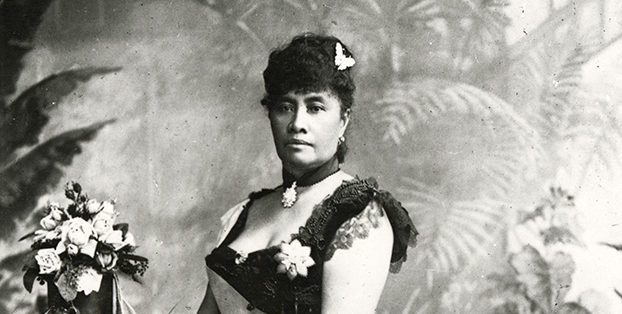We remember Queen Lili‘uokalani on the 184th anniversary of her birth. Lydia Lili‘u Loloku Walania Wewehi Kamaka‘eha was born to High Chief Caesar Kapa‘akea and High Chiefess Analea Keohokālole on September 2, 1838. She became the hānai daughter of High Chief Abner Pākī and High Chiefess Laura Kōnia, birth parents of Bernice Pauahi her hānai sister. Her siblings were: James Kaliokalani, David Kalākaua, Anna Ka‘iulani, Ka‘imina‘auao, Miriam Likelike, and William Pitt Leleiohoku II.
The Queen was a gifted musician, composer, and singer—composing many mele in her lifetime, most notably “Aloha ‘Oe,” “Ku‘u Pua I Paoakalani,” “Sanoe,” “The Queen’s Jubilee,” and “The Queen’s Prayer.” She and her siblings Kalākaua, Likelike, and Leleiohoku earned the nomenclature Nā Lani ‘Ehā (“The royal/heavenly four”) for their musicality. A gifted writer and superb in English, she translated the Kumulipo, the Hawaiian creation chant, into English and wrote her autobiography, Hawaii’s Story by Hawaii’s Queen, about her efforts to preserve the kingdom of Hawai‘i. The Queen loved her people, toured the islands to reach out to them, and during her life gave generously, supplying those in need with clothing, food, medicine and other gifts to fulfill their needs and lift their spirits. She supported the establishment of the Girls Scouts in Hawai‘i, became a member of the American Red Cross, and founded a bank in Honolulu for women named Liliuokalani’s Savings Bank and a money lending group for women in Hilo. Princess Lydia championed public health causes: she helped to confine the smallpox epidemic to O‘ahu, by getting the government ministers to cease travel between the islands in 1881, and got the government board of health to set aside land for a leprosy hospital in Kaka‘ako.
After their younger brother Leleiohoku passed away, her brother King David Kalākaua declared Princess Lydia Lili‘u as his heir apparent. Upon the King’s death in January 1891, Lili‘u succeeded him as monarch, becoming the first female monarch—and the last monarch–of Hawai‘i. During her life, but particularly during her reign as queen, Lili‘u endured many hardships. Despite this, she demonstrated dignity, quiet strength, and always lived with compassion, forgiveness, and a desire for peace.
The Queen was deposed upon the overthrow of the Hawaiian monarchy and annexation to the U.S. in 1898. She lost the crown lands and received no compensation for this. In her later years, she lived on a modest income until her passing on November 11, 1917, at the age of 79.
The Queen loved children and it was said that her clothing had large pockets, in which she kept candy to give to children. Wanting for their well-being and successful future, she left her estate to benefit Hawaiian children in need, through the trust she created in 1909 and which later gave birth to the Queen Lili‘uokalani Children’s Centers on O‘ahu, Hawai‘i, Kaua‘i, and Moloka‘i.
To Queen Lili‘uokalani’s memory, we pay our respects to her life and legacy. PACT is honored to be able to contribute towards her wish for the well-being of Hawaii’s children and now—for all families and residents of Hawai‘i.
We cherish the gift of Kalaulanilawapuni and continue to honor the Queen through our mission and care for Hawaii’s people.
Sources:
- en/Wikipedia.org/wiki/Lili’okalani#
- Girl Scouts of Hawai‘i (gshawaii.org)
- Lili‘uokalani, Ruby Hasegawa Lowe
- The Life of Queen Lili‘uokalani, Lili‘uokalani Trust (onipaa.org/queen-liliuokalani)
- Hawaii State Archives, Queen Liliuokalani Photograph Exhibition, PP-98-11-010


